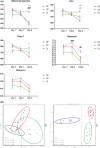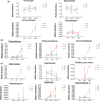Pediococcus pentosaceus LI05 alleviates DSS-induced colitis by modulating immunological profiles, the gut microbiota and short-chain fatty acid levels in a mouse model
- PMID: 32363766
- PMCID: PMC7264873
- DOI: 10.1111/1751-7915.13583
Pediococcus pentosaceus LI05 alleviates DSS-induced colitis by modulating immunological profiles, the gut microbiota and short-chain fatty acid levels in a mouse model
Abstract
The gut microbiota is considered a key factor in pathogenesis and progression of inflammatory bowel disease (IBD). The bacterium Pediococcus pentosaceus LI05 alleviated host inflammation by maintaining the gut epithelial integrity, modulating the host immunity, gut microbiota and metabolism, but its effect on IBD remains unclear. The present study aimed to investigate the role and mechanisms of P. pentosaceus LI05. Mice were administered P. pentosaceus LI05 or phosphate-buffered saline once daily by oral gavage for 14 days, and colitis was induced by providing mice 2% DSS-containing drinking water for 7 days. P. pentosaceus LI05 ameliorated colitis in mice and reduced the body weight loss, disease activity index (DAI) scores, colon length shortening, intestinal permeability and the proinflammatory cytokine levels. Furthermore, a significantly altered gut microbiota composition with increased diversity and short-chain fatty acid (SCFA) production was observed in mice treated with P. pentosaceus LI05. Several genera, including Akkermansia and Faecalibacterium, were differentially enriched in the P. pentosaceus LI05-treated mice and were negatively correlated with colitis indices and positively correlated with gut barrier markers and SCFA levels. The P. pentosaceus LI05 treatment alleviated intestinal inflammation by maintaining the intestinal epithelial integrity and modulating the immunological profiles, gut microbiome and metabolite composition. Based on our findings, P. pentosaceus LI05 might be applied as potential preparation to ameliorate colitis.
© 2020 The Authors. Microbial Biotechnology published by John Wiley & Sons Ltd and Society for Applied Microbiology.
Conflict of interest statement
The authors declare no conflicts of interest.
Figures







Similar articles
-
Pediococcus pentosaceus CECT 8330 protects DSS-induced colitis and regulates the intestinal microbiota and immune responses in mice.J Transl Med. 2022 Jan 15;20(1):33. doi: 10.1186/s12967-022-03235-8. J Transl Med. 2022. PMID: 35033121 Free PMC article.
-
New strain of Pediococcus pentosaceus alleviates ethanol-induced liver injury by modulating the gut microbiota and short-chain fatty acid metabolism.World J Gastroenterol. 2020 Oct 28;26(40):6224-6240. doi: 10.3748/wjg.v26.i40.6224. World J Gastroenterol. 2020. PMID: 33177795 Free PMC article.
-
Probiotic Pediococcus pentosaceus Li05 Improves Cholestasis through the FXR-SHP and FXR-FGF15 Pathways.Nutrients. 2023 Nov 22;15(23):4864. doi: 10.3390/nu15234864. Nutrients. 2023. PMID: 38068723 Free PMC article.
-
Pediococcus pentosaceus MIANGUAN2 Alleviates Influenza Virus Infection by Modulating Gut Microbiota and Enhancing Short-Chain Fatty Acid Production.Nutrients. 2024 Jun 18;16(12):1923. doi: 10.3390/nu16121923. Nutrients. 2024. PMID: 38931277 Free PMC article.
-
Protective effect of Pediococcus pentosaceus Li05 on diarrhea-predominant irritable bowel syndrome in rats.Food Funct. 2024 Apr 2;15(7):3692-3708. doi: 10.1039/d3fo04904c. Food Funct. 2024. PMID: 38488110
Cited by
-
Roles of Short-Chain Fatty Acids in Inflammatory Bowel Disease.Nutrients. 2023 Oct 21;15(20):4466. doi: 10.3390/nu15204466. Nutrients. 2023. PMID: 37892541 Free PMC article. Review.
-
Gut microbiota in pathophysiology, diagnosis, and therapeutics of inflammatory bowel disease.Intest Res. 2024 Jan;22(1):15-43. doi: 10.5217/ir.2023.00080. Epub 2023 Nov 8. Intest Res. 2024. PMID: 37935653 Free PMC article. Review.
-
Oat Peptides Alleviate Dextran Sulfate Sodium Salt-Induced Colitis by Maintaining the Intestinal Barrier and Modulating the Keap1-Nrf2 Axis.Nutrients. 2023 Dec 9;15(24):5055. doi: 10.3390/nu15245055. Nutrients. 2023. PMID: 38140314 Free PMC article.
-
Pediococcus pentosaceus MIANGUAN Enhances the Immune Response to Vaccination in Mice.Probiotics Antimicrob Proteins. 2024 Aug;16(4):1117-1129. doi: 10.1007/s12602-023-10205-z. Epub 2024 Jan 2. Probiotics Antimicrob Proteins. 2024. PMID: 38169032
-
Gut microbiome dysbiosis in patients with hepatitis B virus-related hepatocellular carcinoma after extended hepatectomy liver failure.Ann Transl Med. 2022 May;10(10):549. doi: 10.21037/atm-22-1958. Ann Transl Med. 2022. PMID: 35722392 Free PMC article.
References
-
- Ahl, D. , Liu, H. , Schreiber, O. , Roos, S. , Phillipson, M. , and Holm, L. (2016) Lactobacillus reuteri increases mucus thickness and ameliorates dextran sulphate sodium‐induced colitis in mice. Acta Physiol (Oxf) 217: 300–310. - PubMed
-
- Atarashi, K. , Tanoue, T. , Oshima, K. , Suda, W. , Nagano, Y. , Nishikawa, H. , et al (2013) Treg induction by a rationally selected mixture of Clostridia strains from the human microbiota. Nature 500: 232–236. - PubMed
-
- Bengmark, S. , Di Cocco, P. , Clemente, K. , Corona, L. , Angelico, R. , and Manzia, T. , et al (2011) Bio‐ecological control of chronic liver disease and encephalopathy. Minerva Med 102: 309–319. - PubMed
Publication types
MeSH terms
Substances
LinkOut - more resources
Full Text Sources

